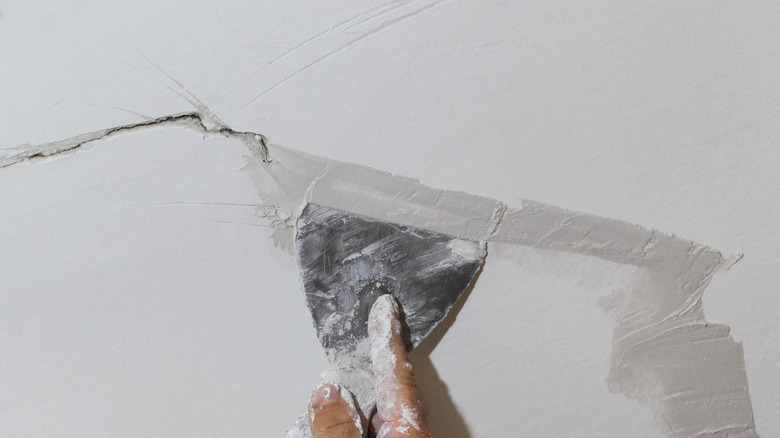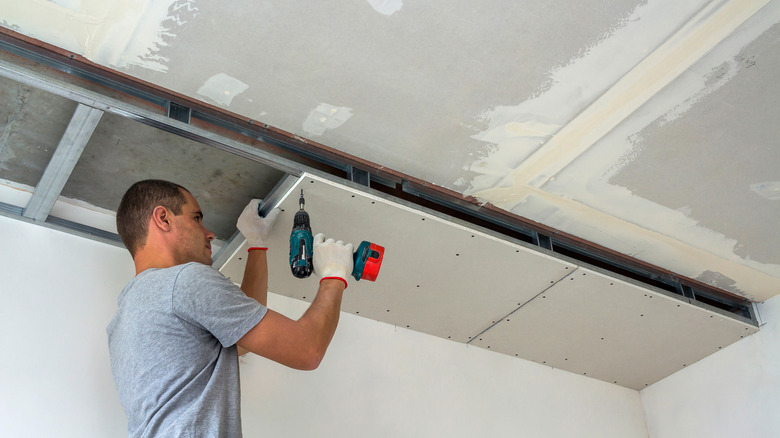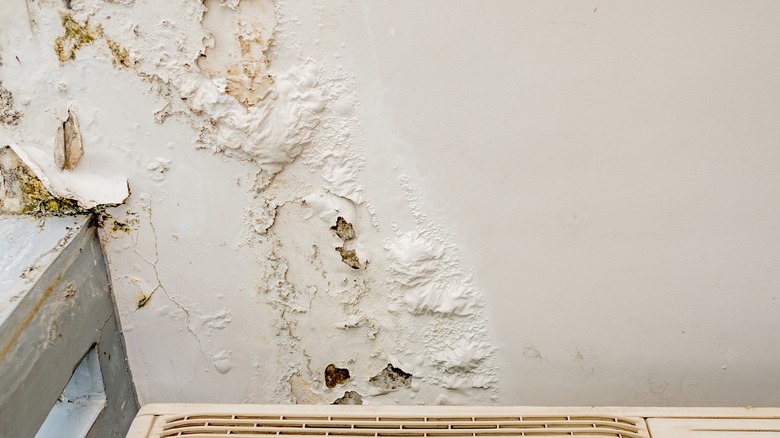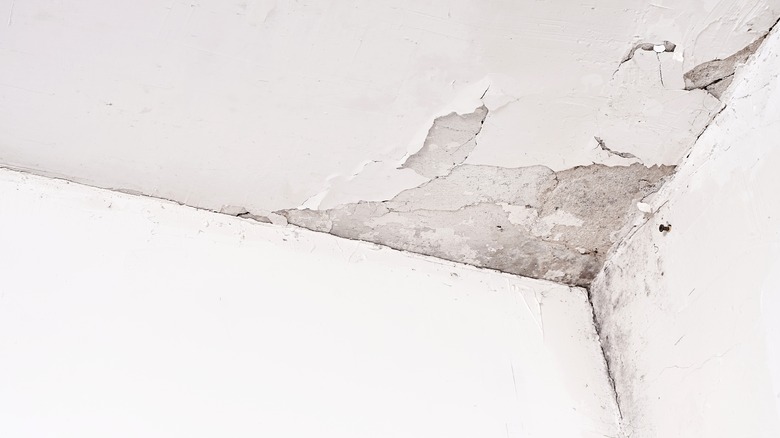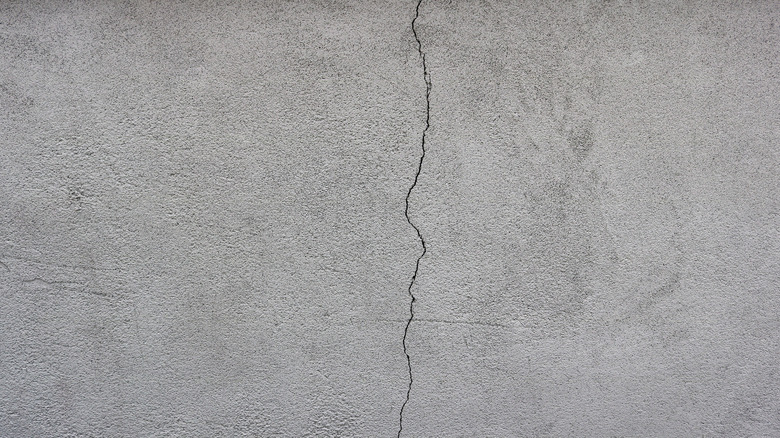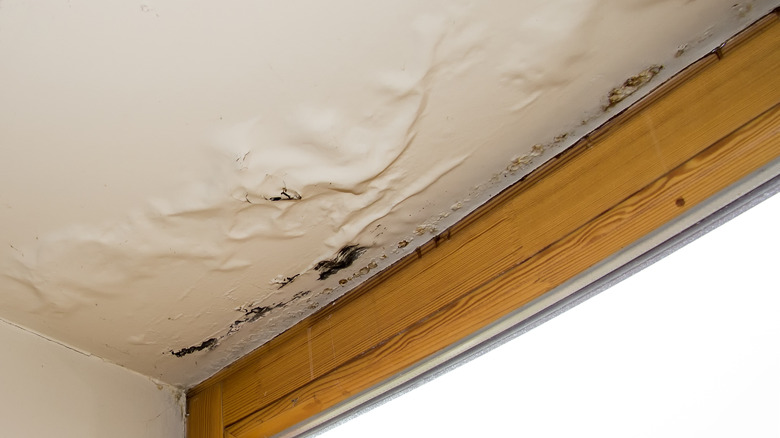5 Potential Causes For The Cracks In Your Ceiling
Whether you're looking into buying a new home or have had one for years, there are always a few things to look out for to make sure your house is in great condition. Cracks in the ceiling are the most important to keep an eye out for, and they can lead to structural damage if they don't get resolved quickly, according to Epp Foundation Repair. Structural ceiling cracks are the most serious since they can affect the entirety of the home. Non-structural ceiling cracks aren't as damaging but still should be fixed so that they don't create a bigger problem.
There are different reasons that could cause cracks in your ceiling and should be looked into by a professional, so there isn't long-term damage. They can appear in various sizes across your ceiling, claims Dalinghaus Construction, ranging from minor to as severe as hairline cracks, brown ceiling cracks, spider web ceiling cracks, and bowed ceiling cracks. You'll be able to tell when you should call a professional or attempt to fix them yourself. Here are a few causes for the cracks in your ceiling.
1. Drywall improperly installed
Drywall is plasterboard made from gypsum plaster used for the ceiling, according to Corrosionpedia. It's been used in homes since 1916 in the United States. Drywall replaced wood and concrete because it was a cheaper investment that was easier to install, but wasn't as sturdy. If your drywall wasn't installed properly when construction workers first build the home, it could be susceptible to cracks. When the drywall is put in, drywall mud is used to keep the sheets together, which is then taped to keep it in place, per Al's Taping Tools & Spray Equipment.
The drywall isn't correctly installed when the tape starts lifting, which could cause cracks in your ceiling. They're simple to repair with extra drywall, mud, and tape to hold everything together when you fill the gaps. They don't usually require a professional, but you can contact one if you want it to last longer and be secured.
2. Water damage
Water from rain or just your bathtub could cause cracks in your ceiling. Unresolved water leaks could lead to cracks forming and mold appearing, which would have to be taken care of by a professional, states Entrusted. Once you start noticing cracks, check for leaks in the area or call a professional to inspect the pipes in case it isn't coming from the bathroom or roof. If too much water starts to pool in your ceiling, it could also cause holes.
If you do not see any cracks, you may be dealing with minor leakage if very little water is seeping through. Entrusted suggests paying attention to your water bill to check for any changes. If your water bill shows an increase and you've been using the same amount of water, then there could be a leak somewhere in your home that should be looked into as soon as possible.
3. Truss lift
If you notice a crack where the ceiling meets the walls in the corner, then you have a truss lift problem. This happens when the tape of the drywall comes undone, according to This is Drywall. It usually occurs in the winter due to the weather change since it rains more and there's more moisture in the air. The trusses are the wood foundation of the home, which with the weather change, can expand and shrink, causing cracks.
This is Drywall claims that truss lifts aren't a structural issue — they're a recurring problem due to the elements, so these cracks can happen annually in the same spots. They're easy to repair with more tape, and if the screws pop out, they can be replaced with new ones. An excellent way to prevent it from reoccurring is to install a crown molding to not only cover the cracks but also secure the drywall, tape, and screws in place.
4. Heavy items
While second floors should be the strongest floor, they can still weaken if it's holding too many heavy items at once. Since it contains everything from beds to bathtubs to dressers, the ceiling could have a few cracks appear over time. Once you start noticing them, remove the heavy items to give it a break. Johnny Holland claims that a second-floor living room can hold up to 6,000 pounds but drops down to 4,500 pounds in a bedroom. Knowing how much weight your space can hold will make it easier to figure out how many furniture pieces to place in it.
If it's a bathtub that is creating the cracks, you'll want to check to see if it's the tub itself or if there's water leaking. If it's the tub, you'll want a professional to go in and fix the drywall and possibly the foundation of the ceiling so that it supports the bathtub better. If you have a one-story home, you can check to see if your attic has any heavier items that should be moved to a different location. To prevent cracks from forming, you can move around heavy items every six months to keep the drywall leveled throughout the year.
5. Foundation problems
Ceiling cracks can also be caused by the foundation of your home, which could be more damaging if they're not fixed as soon as possible. If you notice the ceiling cracks to be a quarter-inch long that continues to form through the area, stairstep through the drywall, or start from door or window frames, then you should have a professional look at your foundation, claims Dalinghaus Construction. You never want to try fixing those ceiling cracks in your home because if the foundation isn't resolved, your ceiling could fall to the floor.
A damaged foundation could be caused by poor drainage, which will induce oversaturation of soil, making the home unstable, according to Edens Structural Solutions. Other causes include bad construction, overwatering your lawns, termites, etc. You definitely want to keep an eye out for these occurrences when you buy a new home or as your home ages so that you can fix things if needed. It's also a great way to prevent ceiling cracks if you're taking care of the entirety of your home.
